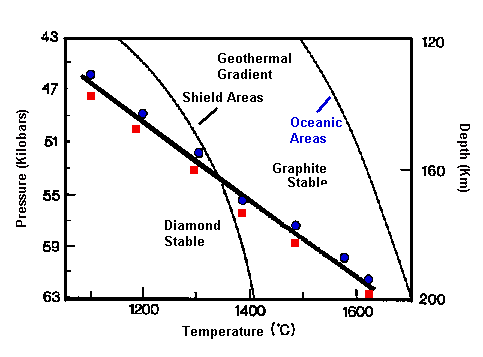As a student, I am fascinated with economically important ore minerals such as diamonds. If we look beyond the jewelry aspect, diamonds are used in variety of applications. Diamonds are made of pure native carbons. Pure carbon can exist as a mineral in two different variations in nature; graphite and diamond.
The graphite prefers to form sheets with iconic bonds between them. While these sheets are strong in one direction, they are weak in the axis where the ionic bonds are exposed.
The unique properties of diamond come from the chemical structure of strong covalent bonds between tightly packed carbon atoms. It does not have planes of weaknesses. Using these chemical and physical properties, some companies have synthetically produced diamonds and carbon fiber. In fact, in 2012 natural diamond exploitation is far below the synthetic diamond production. Then why are natural diamonds still valuable?
Natural Diamonds
The answer to that question can come in two different forms. The scientific reason is that the naturally occurring high grade diamonds mineral have far better properties of conductivity (electrical and thermal), strength and refractivity than synthetic diamonds . The diamonds used in industrial applications are usually lower grade (higher the grade better the bond strength and purer it is) than that of used in expensive jewelry. In some situations, such as diamond cutters may only require one or few properties of diamond. In that case, companies choose cheaper low grade natural diamonds over synthetic. In some equipment such as lens crafting machines, we use low grade natural diamonds because we need few (if not all) of the properties of the mineral.
The second reason why diamonds are expensive is the economics. The economic model of human civilization can be summarized as supply and demand. The two major countries that produce significantly enough high grade diamonds would be Canada and South Africa. Other countries like Russia and US produce only the low grade version of the mineral. This is because suitable sites for diamond exploration are hard to find. Even after we find an ore, usually it will be the only site in that particular country. This results in fluctuation in prices as economies go up and down. With the increased use of the mineral, the demands for both high grade and low grade diamonds have far exceeded the availability and the production rate of mines around the world.
The diamond ores are rare because they were formed in the mantle (depths over 100 km) under high pressure and temperature conditions. In order to mine diamonds, they has to be brought up to the surface at extremely rapid speeds to prevent it from turning into graphite. In fact, diamond is unstable at the surface.
This is where Kimberlite pipes acts as the transporter for diamonds. Kimberlite pipes were believed to be travelled upwards of 10 -30 km/hr passing through the graphite stability field. They are very rare in nature. Since they are small volcanic pipes that undergone matasomatism, currently there are no active pipes on Earth. The diamond xenocrysts in erupted pipes have been dated back to as far as the Archean (over 2.5 Ga). Presence of a Kimberlite pipe, does not always translate that into an ore deposit. The only way for the pipes to bring the materials up to the surface, is to pass through an area that already has formed diamonds. As a result, it is difficult to find a diamond ore than to finding other ore deposits.
Recycle Diamonds
Some of the ore deposits like gold or aluminum can be recycled. Diamonds are not always recyclable. If you damage a gold electrode on a machine, you can always melt it down and form a new one from the same materials. However, if you damage a diamond rod, it is difficult to bring back to the original condition.
As Geologists we should promote sustainable exploration of diamonds. The limited abundance of diamond ores can create not only inflated prices for the commodity, but it may hinder our ability to mine it in the future.

